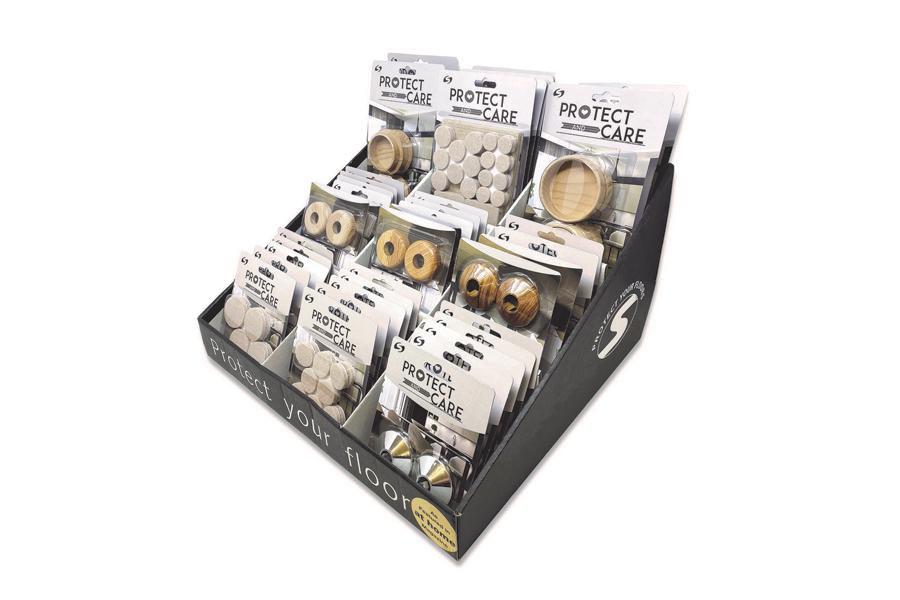Whatever type of flooring you have it needs protecting, as when furniture and flooring meet, there is friction and can be damage. Gill takes a look at what you can do to cushion the blow.
Whatever type of flooring you have – wood, laminate, etc – it needs protecting. The fact is that when furniture and flooring meet, there is friction and can be damage. So, let’s look at what you can do to cushion the blow.
Protection in five ways before problems happen
Most protection solutions protect you in five ways:
- Protects flooring from the impact of furniture
- Protects furniture joints from being fatally weakened
- Protects ears from noise
- Protects from back pain as furniture slides easier
- Protects from customer complaints and insurance claims
What protection do I need?
- For solid wood, laminates and hard tiled flooring: use self-adhesive felt or glides such as QuickClick.
- For carpet, rugs and vinyl flooring: use glides such as Furni-glides or QuickClick Glides.
- Self-adhesive felt
- Why buy?
- It’s the cheapest option. On a roll from Stroolmount, for example, they can cost as little as a penny each. It’s a short-term solution: if you want a longer-term solution, choose glides such as QuickClick.
- Flooring type
- Use on all solid wood, laminates, tiles and vinyl. Probably best on furniture that’s not moved often.
- Fit it in seconds
- Just peel back the cover and stick on the furniture feet. Allow it to set firmly for 24 hours.
- Sizes
- Available in a variety of sizes and shapes from circles and oblongs to L-shapes up to 75mm.
- Ideal type of furniture
- Coffee tables, lamp tables, bedside tables, dining tables, storage cabinets, desks, workstations and filing cabinets.
Top tip 1: Check for grit on the feet before you add the felt so it’s not scratched along your floor.
Top tip 2: Beware of companies skimping on thickness. You need a minimum of 5mm thickness to cushion flooring from furniture.
Top tip 3: Beware of using self-adhesive felt with heated floors: the glue doesn’t stick properly, so extra care needs to be taken. With metal leg furniture, self-adhesive felt may be the only protection option, so it’s always best to let customers know that they need to keep an eye out for any movement. Advise them to replace them immediately if they become unstuck as it’s cheaper to do this than replace the whole floor.
Furni-Glides
- Why buy?
- Glides are a longer-term solution than self-adhesive felt. Without glides, the legs and feet of furniture can get anchored and you can feel the fatal lurch as the furniture joints are fatally weakened.
- Flooring type
- Use glides like Furni-glides on all flooring types. Especially useful on carpets and rugs, as they reduce the friction from the fibres which can anchor the feet of furniture.
- Sizes
- Furni-glides are available in sizes from 22-63mm diameters.
- Fixings
- Available as self-adhesive glides (allow 24 hours for it to stick firmly); and as a screw-in option. Screw-in glides are a more permanent solution than self-adhesive glides. But self-adhesive options may be the only option for furniture with metal legs.
- Ideal type of furniture:
- Heavy furniture, eg, wardrobes, chests of drawers, ottomans, beds, sideboards, Welsh dressers, sofas and armchairs, dining tables, office furniture, storage cabinets, desks, workstations and filing cabinets.
Top tip 1: Keep the floor really clean before the glide is applied so that no dirt gets scraped along.
Top tip 2: Self-adhesive Furni-glides do not work on heated floors. Because the heat ‘melts’ the glue and so the glide moves around as it doesn’t stick properly. So you’d need the screw-in version.
Top tip 3: Beware of using self-adhesive Furni-glides with heated floors: the glue doesn’t stick properly, so extra care needs to be taken. With metal leg furniture, screw-in Furni-glides may not be possible. Self-adhesive felt may be the only protection option, so it’s best to let customers know that they need to keep an eye out for any movement. Advise them to replace them immediately if they become unstuck as it’s cheaper to do this than replace the whole floor.
Gill Finch is managing director at Stroolmount


